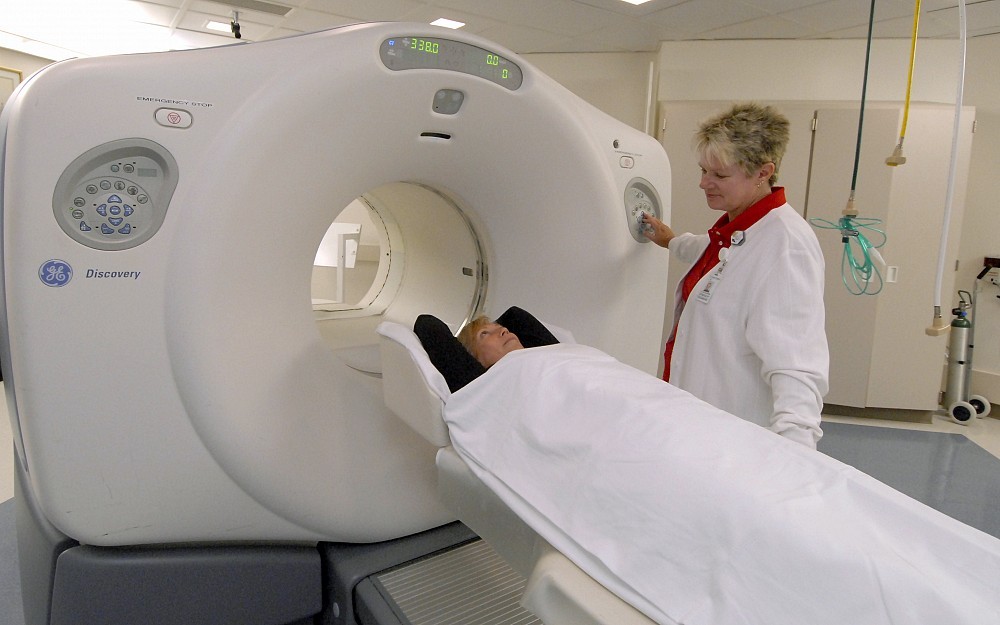
Region s First High-Risk Lung Cancer Screening Program Now Open
CINCINNATILung cancer screening is now available for Tristate residents who are at an increased risk for lung cancer. Individuals who have smoked a pack of cigarettes a day for more than 20 years and those with a prior lung cancer diagnosis are considered at the highest risk.
The UC Cancer Institute Lung Cancer Screening Programthe first of its kind in the Tristate and among a handful nationwideuses low radiation dose chest computed tomography (CT) scans for screening. Screening is used to identify unrecognized disease in people who have no signs or symptoms in an attempt to intervene earlier when disease is generally more treatable.
Screening CT scans are offered at both UC Health University Hospital (Clifton) and University Pointe Surgical Hospital Imaging Center (West Chester). Scans are performed under a strict clinical protocol that capitalizes on the expertise of the entire multidisciplinary UC Cancer Institute Lung Cancer Team to produce the most accurate results for patients.
In 2011, the National Cancer Institute published data supporting chest CT scans as an effective lung cancer screening tool for a high-risk patient population. The study showed that when heavy smokers were screened with low-radiation dose CT scans versus traditional chest X-rays, there was a 20 percent reduction in lung cancer-related deaths. A separate UC-based trial evaluating chest CT scans in a population of 132 heavy smokers also supported the imaging technique as a viable screening tool in a high risk population.
Traditional chest X-ray produces a flat, two-dimensional picture. With CT scanning, the X-ray tube is rotated around the patient during the imaging test to create a 3D picture of the chest.
"This allows lung cancer specialists to view the lungs once slice at a time. Nodules that are too small to show up on a chest X-ray are more likely to be detected and specialists can more accurately follow up on concerning lesions, says Sandra Starnes, MD, chief of thoracic surgery at the UC College of Medicine and UC Health thoracic surgeon with the UC Cancer Institute.
Starnes estimates that 90 percent of lung cancer diagnoses are made in current or former smokers.The Greater Cincinnati area has a lung cancer rate that is consistently higher than the general population, primarily due to our regions high smoking rate.
Unlike breast, colorectal and prostate cancers, until recently there was no nationally accepted lung cancer screening tool for the general population.
"Having a practical clinical toolbacked by scienceto help us identify lung cancer earlier in the people who are most at risk is an exciting development we hope will save lives and reduce unnecessary invasive testing for patients, adds John Morris, MD, UC Health medical oncologist and director of the UC Cancer Institute Experimental Therapeutics and Thoracic Cancer Programs.
Lung cancer is the leading cause of cancer-related death for both men and women, with more than 222,000 expected new diagnoses in 2012, according to the National Cancer Institute. Tobacco use is the No. 1 risk factor for lung cancer.
The National Comprehensive Cancer Network along with several other societies now recommends CT screening in a high-risk population for lung cancer. The procedure is not currently covered by insurance, however, the screening test is being offered through UC Health at a low out-of-pocket cost.
Appointments and Referrals
To reach the Lung Cancer Screening Program, call 513-584-LUNG or learn more at uccancer.com/lungcancer. To reach the Win By Quitting Smoking Cessation Clinic, call 513-584-QUIT.

Sandra Starnes, MD, is chief of the thoracic surgery division for the UC College of Medicine Department of Surgery.

John Morris, MD
Related Stories
Poll shows grandkids help grandparents feel less lonely
November 14, 2024
The role of a grandparent is multifaceted and valuable, especially when families are facing a childcare crisis or when someone needs to fill the "parent" role for unforeseen reasons. Despite some of the immediate impact that grandparents have on grandkids, new data suggests the benefits flow both ways. A recent poll conducted by the University of Michigan shows the importance of grandchildren in grandparents' lives.
Exploring the differences between men and women with traumatic...
November 14, 2024
The University of Cincinnati's Brandon Foreman joined a panel discussion on WVXU's Cincinnati Edition discussing current knowledge and the need for further research into the differences between. men and women experiencing traumatic brain injuries.
The long and complicated — and expensive — effort to replace...
November 13, 2024
Cincinnati's public water utility is on a years-long effort to replace its lead service lines, guided by a model designed by Christopher Auffrey, a professor of planning at DAAP. The EPA has just ramped up the deadline for replacements across the U.S. and professor and city officials discussed the undertaking on NPR's "All Things Considered."
